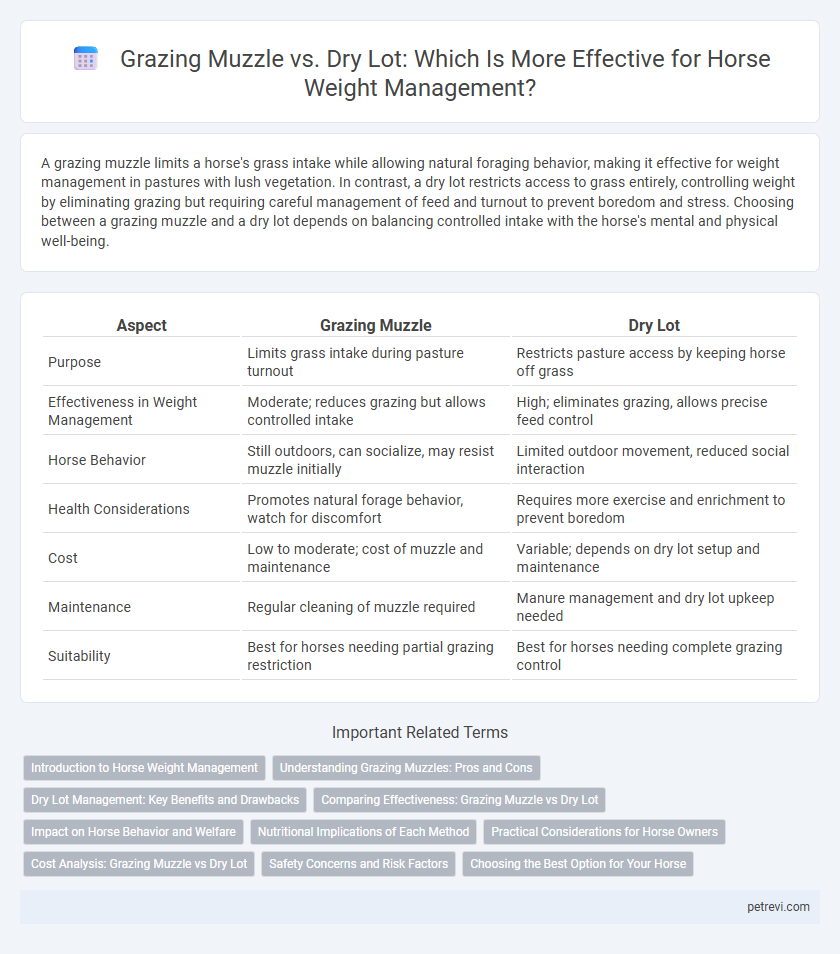A grazing muzzle limits a horse's grass intake while allowing natural foraging behavior, making it effective for weight management in pastures with lush vegetation. In contrast, a dry lot restricts access to grass entirely, controlling weight by eliminating grazing but requiring careful management of feed and turnout to prevent boredom and stress. Choosing between a grazing muzzle and a dry lot depends on balancing controlled intake with the horse's mental and physical well-being.
Table of Comparison
| Aspect | Grazing Muzzle | Dry Lot |
|---|---|---|
| Purpose | Limits grass intake during pasture turnout | Restricts pasture access by keeping horse off grass |
| Effectiveness in Weight Management | Moderate; reduces grazing but allows controlled intake | High; eliminates grazing, allows precise feed control |
| Horse Behavior | Still outdoors, can socialize, may resist muzzle initially | Limited outdoor movement, reduced social interaction |
| Health Considerations | Promotes natural forage behavior, watch for discomfort | Requires more exercise and enrichment to prevent boredom |
| Cost | Low to moderate; cost of muzzle and maintenance | Variable; depends on dry lot setup and maintenance |
| Maintenance | Regular cleaning of muzzle required | Manure management and dry lot upkeep needed |
| Suitability | Best for horses needing partial grazing restriction | Best for horses needing complete grazing control |
Introduction to Horse Weight Management
Horse weight management involves balancing caloric intake with energy expenditure to maintain optimal health and performance. Grazing muzzles restrict pasture access, reducing calorie consumption without limiting time on grass, while dry lot management confines horses to a non-pasture area to control forage intake completely. Selecting the appropriate method depends on the horse's metabolism, weight goals, and available resources for sustained management.
Understanding Grazing Muzzles: Pros and Cons
Grazing muzzles help control a horse's intake of pasture grass by limiting bites, reducing the risk of obesity and laminitis. They allow horses to engage in natural grazing behavior while preventing overconsumption, but can cause discomfort or skin irritation if not properly fitted or monitored. Dry lots restrict pasture access entirely, which prevents grass intake but may require increased forage supplementation to meet nutritional needs.
Dry Lot Management: Key Benefits and Drawbacks
Dry lot management for horse weight control offers precise regulation of forage intake, helping prevent obesity and related metabolic disorders. It minimizes access to pasture toxins and reduces exposure to parasites commonly found in grazing environments. However, limited turnout can lead to behavioral issues such as cribbing or stall walking, requiring careful monitoring and enrichment strategies.
Comparing Effectiveness: Grazing Muzzle vs Dry Lot
Grazing muzzles effectively limit a horse's grass intake while allowing natural grazing behavior and social interaction, making them ideal for controlling calorie consumption on pasture. Dry lots restrict access to pasture entirely, preventing overconsumption but requiring supplemental forage like hay to maintain fiber intake. Both methods support weight management, with grazing muzzles offering controlled grazing alongside pasture turnout, whereas dry lots provide stricter intake regulation at the cost of reduced natural foraging.
Impact on Horse Behavior and Welfare
Grazing muzzles limit forage intake, helping control weight without completely restricting natural grazing behavior, which supports mental well-being and reduces stress-related behaviors. Dry lots prevent access to pasture but may increase boredom and frustration, potentially leading to stereotypies like cribbing or weaving. Selecting the appropriate method depends on balancing dietary control with maintaining positive behavioral welfare for optimal horse health.
Nutritional Implications of Each Method
Grazing muzzles limit a horse's intake of pasture by restricting bite size, effectively reducing calorie consumption and managing weight without completely eliminating forage nutrients like fiber and vitamins. Dry lots restrict grazing entirely, prompting reliance on controlled hay feeding, which allows precise nutrient balance but may risk deficiencies in natural antioxidants and fresh forage elements. Each method impacts nutrient intake profiles differently, influencing digestion, microbiome health, and overall metabolic balance in equine weight management programs.
Practical Considerations for Horse Owners
Grazing muzzles offer precise control over a horse's grass intake, reducing caloric consumption while allowing natural grazing behavior, which is effective for weight management in pasture settings. Dry lots limit access to grass entirely, simplifying calorie restriction but requiring increased management to prevent boredom and ensure sufficient turnout time. Horse owners should balance the horse's behavioral needs, pasture quality, and daily monitoring capacity when choosing between grazing muzzles and dry lots for effective weight control.
Cost Analysis: Grazing Muzzle vs Dry Lot
Grazing muzzles typically cost between $50 and $150, representing a one-time investment with occasional replacement expenses, while dry lots involve higher recurring costs such as land maintenance, fencing, and bedding materials. The initial setup of a dry lot can exceed $500 depending on size and infrastructure, making it more expensive upfront compared to a grazing muzzle. Over time, grazing muzzles offer a more cost-effective solution for horse weight management, especially for owners seeking to limit their horse's pasture intake without investing heavily in land modifications.
Safety Concerns and Risk Factors
Grazing muzzles reduce calorie intake by limiting pasture consumption, lowering the risk of obesity-related issues such as laminitis, but improper fit can cause chafing or breathing difficulties, requiring regular monitoring for safety. Dry lots prevent access to grass entirely, mitigating the risk of pasture-related colic and excessive weight gain, yet they may increase the likelihood of stall vices and stress-induced behaviors if turnout time is insufficient. Understanding individual horse tolerance and providing balanced nutrition alongside appropriate turnout management are critical to minimizing safety risks during weight control.
Choosing the Best Option for Your Horse
Choosing between a grazing muzzle and a dry lot depends on your horse's specific weight management needs and lifestyle. Grazing muzzles allow controlled pasture access by limiting grass intake, helping overweight horses maintain a healthy diet without sacrificing turnout benefits. Dry lots provide a grass-free environment to prevent overeating, making them ideal for horses requiring strict restriction but may reduce natural behaviors associated with grazing.
Grazing Muzzle vs Dry Lot for Horse Weight Management Infographic

 petrevi.com
petrevi.com